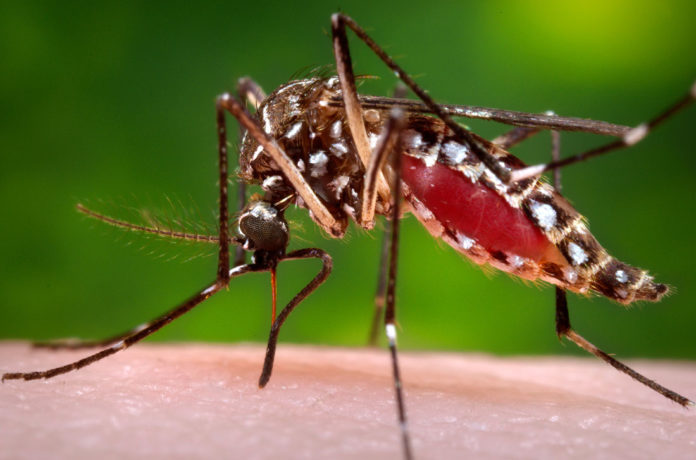
A non-native Aedes aegypti mosquito—an aggressive species that can spread certain diseases—has been discovered in a residential area of Gilroy, according to the Santa Clara County Vector Control District. A mosquito of the same species was also found recently in a neighborhood of east San Jose.
The county is monitoring the Gilroy area and will soon begin treatment to eradicate the mosquito, which is known to spread diseases including dengue and yellow fever, the county said. Officials hope to eradicate the Aedus aegypti before it can establish a permanent population.
The district identified a female Aedes aegypti mosquito in the area surrounding Hanna and West Tenth streets in Gilroy. Eradication efforts include trapping adult mosquitoes, inspecting nearby properties for mosquito larvae and habitat and treating any larvae they find with pesticide.
“The district will escalate its mosquito-control methods as needed to include backpack spraying, barrier spraying, and wide area larvicide spraying, which is done with the use of truck-mounted equipment and would be conducted in a series of treatments,” the vector control district said in a press release.
Similar eradication efforts are ongoing in an East San Jose neighborhood where the Aedes aegypti has been identified.
The county is asking residents to allow district staff to access their properties, if requested, to check for mosquitoes and treat them, says the release.
Residents of Gilroy and East San Jose are also asked to check their properties for standing water—a common breeding habitat for mosquitoes—and remove it, the county said.
The Aedes aegypti, if it gains a foothold in Santa Clara County, could threaten public health and affect residents’ quality of life, the county warned. The mosquitoes are “highly aggressive” and active during daytime—unlike native mosquito populations that are most active in the cooler morning and evening temperatures.
“We are doing everything we can to prevent Aedes aegypti from becoming established in Santa Clara County—and we need the public’s help,” said Edgar Nolasco, director of the County of Santa Clara Consumer and Environmental Protection Agency. “It’s important for residents in the affected area to cooperate with district staff and allow them to inspect their properties for mosquitoes and mosquito habitat.”
For residents who worry about their privacy, the district said that staff who enter residential properties are not authorized to do anything besides check for mosquitoes and provide mosquito control as needed. The inspections are provided at no cost to residents.
Officials from the Vector Control District and County Public Health Department will hold a community meeting at 6pm Sept. 26 to inform residents about the treatments and answer their questions. The meeting will take place in the cafeteria of Gilroy High School, 750 West Tenth Street in Gilroy.
Though it is not native to California, Aedes aegypti is present in 19 counties throughout the state, mostly in the Central Valley and Southern California, the press release continued. It has the potential to transmit several viruses, including those that cause dengue, chikungunya, Zika and yellow fever.
These viruses are not endemic to California, but there have been occasional cases of these diseases being transmitted by travelers returning from parts of the world where the viruses are prevalent.
The invasive species is about a quarter-inch in size with black and white stripes on its back and legs, the district said. It feeds almost exclusively on humans and does not fly long distances, venturing fewer than 500 feet from where it hatches.
Aedes aegypti is aggressive and bites at any time of day. These mosquitoes are “container breeders,” preferring to lay their eggs just above the water line in small, artificial sources of water such as buckets, pet dishes, fountains and bird baths, plant pots and saucers and old tires, said the press release. Once laid, the eggs can last for more than a year without water.
Residents should look around their property and dump out even the smallest amount of standing water, the district advised. Cleaning and scrubbing bird baths, pet dishes and other containers is a good way to remove any lingering Aedes aegypti eggs, which are about half a millimeter in size and look to the naked eye like tiny bits of dirt.
Residents should also properly screen rain barrels, cisterns and irrigation drains to prevent mosquito access; fix leaky water faucets and broken sprinkler heads and avoid overwatering outside; ensure window and door screens are in good condition with no holes or tears and are tight-fitting; make sure the water level of swimming pools is adequate for proper circulation and filtration.
To protect yourself from mosquito bites, the district advises:
- Apply insect repellents containing EPA-registered ingredients such as DEET, picaridin, IR3535 or oil of lemon eucalyptus, always following label instructions.
- Wear long-sleeve shirts, pants, socks and shoes when mosquitoes are most active.
- Make sure your window and door screens are in good condition.
Residents experiencing mosquito bites during the day should report them immediately to the Vector Control District at 408.918.4770 or ve********@********ov.org. The district encourages residents to email photographs of mosquitoes with black and white stripes to the same address.
If you are sick with fever, headache and joint or muscle pain after returning from an area where dengue, chikungunya, yellow fever or Zika occurs, contact your doctor, and stay indoors as much as possible to avoid mosquito bites and help prevent the possible spread of the virus, the district said.
To reduce the population of Aedes aegypti, the district uses pesticides that are approved by the federal and state environmental protection agencies and are widely used by vector control agencies throughout California, the press release added.
The California Department of Public Health tests the mosquitoes trapped by the district for any viruses. To date, none of the viruses that potentially can be transmitted by Aedes aegypti mosquitoes have been transmitted in Santa Clara County.









